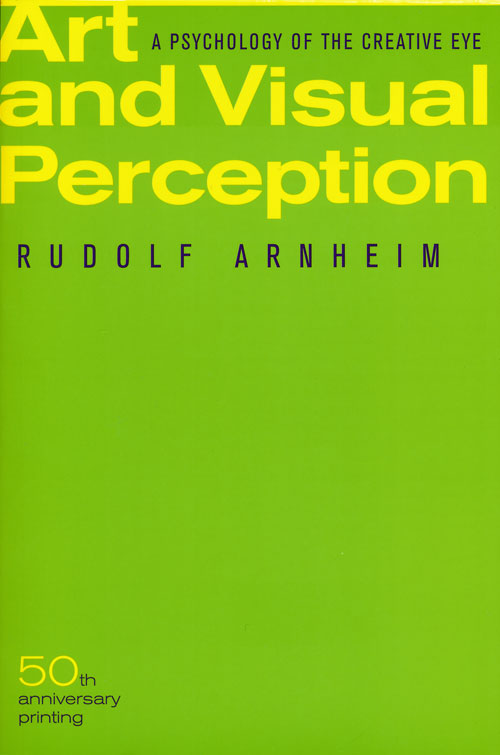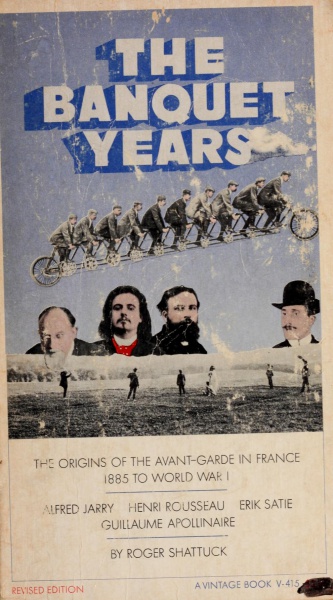Rudolf Arnheim: Art and Visual Perception (1954–) [EN, RU, PL, RO, ES, BR-PT]
Filed under book | Tags: · architecture, art theory, colour, kinesthesia, light, movement, music, painting, perception, perspective, physiology, psychology, sculpture

“Since its publication in 1954, this work has established itself as a classic. It casts the visual process in psychological terms and describes the creative way one’s eye organizes visual material according to specific psychological premises. In 1974 this book was revised and expanded, and since then it has continued to burnish Rudolf Arnheim’s reputation as a groundbreaking theoretician in the fields of art and psychology.”
Publisher University of California Press, 1954
Expanded and revised edition, 1974
ISBN 0520243838
508 pages
Interview with the author (Uta Grundmann, Cabinet, 2001)
Publisher (EN)
Art and Visual Perception (English, 1954/1974, 26 MB)
Iskusstvo i vizualnoe vospriyatie (Russian, trans. V.N. Samokhin, 1974/2000, DJVU, no OCR)
Sztuka i percepcja wzrokowa (Polish, trans. Jolanta Mach, 1978, 24 MB, no OCR, via nuitienne)
Arta si perceptia vizuala (Romanian, trans. Florin Ionescu, 1979, 35 MB, no OCR, via)
Arte y percepción visual (Spanish, trans. María Luisa Balseiro, 1979/1997, 43 MB)
Arte e percepção visual (Brazilian Portuguese, trans. Ivonne Terezinha de Faria, 1980/2005)
André Malraux: The Voices of Silence (1951–)
Filed under book | Tags: · art history, art theory, museum, painting, philosophy of art, photography, sculpture

“This is not a history of art, but a work on the sculptor’s and painter’s arts of the world by a passionate art lover. The organization is by ideas; the illustrations are drawn from all peoples, countries, and times. Each picture is placed within a page or two of its discussion in the text. As an idea develops, the places and periods of its illustrations wander. The coherence is an inward one, not one of objective order.
Malraux starts from the premise that with the broadening of our knowledge of the world, and especially by the aid of archeology and photography, the many visual arts developed by the human race in its history are now mainly known and accessible. They are as it were in one grand museum without walls–the museum of our cognizance.
Further, they are known to many creative artists, and will be known to more, and will influence them. In other words, the situation no longer exists which has characterized the appearance of most arts heretofore, namely of growing up insulated, in regional solitude and self-sufficiency. From now on, the history of human visual art will be of a new order.
Another idea Malraux develops is that while painting and sculpture do represent objects, the artist, contrary to legend and public opinion, develops his work out of his ability to see–not nature, but his predecessors, and to transcend them. Style is thus a social phenomenon, an interrelation of men through their works.” (from a review by A.L. Kroeber, American Anthropologist, 1957)
Originally published in 3 volumes as Psychologie de l’art, 1947-49, the work had been thoroughly rewritten and published as Les Voix du silence, Gallimard, 1951.
Translated by Stuart Gilbert
First published in English by Doubleday, 1953
Reprinted by Secker & Warburg, London, 1954, 661 pages
Publisher Paladin, UK, 1974, 679 pages
Reviews: Maurice Blanchot (1950/1997), William Barrett (Saturday Review, 1953).
PDF (1954, 44 MB, no OCR, IA, added on 2023-5-3)
PDF (1974, 81 MB, no OCR)
Roger Shattuck: The Banquet Years: The Origins of the Avant-Garde in France, 1885 to World War I., Rev. ed. (1955/1968)
Filed under book | Tags: · 1880s, 1890s, 1900s, 1910s, absurd, anarchism, art, art history, avant-garde, cubism, dada, dreams, france, literature, logic, montage, music history, painting, pataphysics, poetry, theatre, typography

In this book Roger Shattuck portrays the cultural bohemia of turn-of-the-century Paris who carried the arts into a period of renewal and accomplishment, and laid the ground-work for Dada and Surrealism.
“…Then came the idea–a kind of gambler’s hunch–that the trio Rousseau-Satie-Apollinaire represented several significant aspects of the period and could reveal them better than any single figure. The idea would not die. [..] Jarry had forced his way into the group and established himself close to the center of things. He helped clarify my underlying subject: how the fluid state known as bohemia, a cultural underground smacking of failure and fraud, crystallized for a few decades into a self-conscious avant-garde that carried the arts into a period of astonishingly varied renewal and accomplishment. [..] An enormous amount has been written on this era and these men since the first edition of this book in 1958. I have taken account of some of it by changing those passages where new facts have come to light.” (from the Preface to this edition)
First published in 1955
Publisher Vintage Books, 1968
397 pages
Review (Alfred Kazin, The Reporter, 1958)
Review (Sidney Tillim, College Art Journal, 1959)
Review (Justin O’Brien, The Saturday Review, 1958)
PDF (115 MB, no OCR)
Comment (0)
